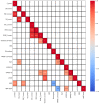Exploring the Association Linking Head Position and Sleep Architecture to Motor Impairment in Parkinson's Disease: An Exploratory Study
- PMID: 38003906
- PMCID: PMC10671918
- DOI: 10.3390/jpm13111591
Exploring the Association Linking Head Position and Sleep Architecture to Motor Impairment in Parkinson's Disease: An Exploratory Study
Abstract
Patients with Parkinson's disease (PD) tend to sleep more frequently in the supine position and less often change head and body position during sleep. Besides sleep quality and continuity, head and body positions are crucial for glymphatic system (GS) activity. This pilot study evaluated sleep architecture and head position during each sleep stage in idiopathic PD patients without cognitive impairment, correlating sleep data to patients' motor and non-motor symptoms (NMS). All patients underwent the multi-night recordings, which were acquired using the Sleep Profiler headband. Sleep parameters, sleep time in each head position, and percentage of slow wave activity (SWA) in sleep, stage 3 of non-REM sleep (N3), and REM sleep in the supine position were extracted. Lastly, correlations with motor impairment and NMS were performed. Twenty PD patients (65.7 ± 8.6 y.o, ten women) were included. Sleep architecture did not change across the different nights of recording and showed the prevalence of sleep performed in the supine position. In addition, SWA and N3 were more frequently in the supine head position, and N3 in the supine decubitus correlated with REM sleep performed in the same position; this latter correlated with the disease duration (correlation coefficient = 0.48, p-value = 0.03) and motor impairment (correlation coefficient = 0.53, p-value = 0.02). These preliminary results demonstrated the importance of monitoring sleep in PD patients, supporting the need for preventive strategies in clinical practice for maintaining the lateral head position during the crucial sleep stages (SWA, N3, REM), essential for permitting the GS function and activity and ensuring brain health.
Keywords: PD; glymphatic system; head position; sleep profiler; slow wave activity.
Conflict of interest statement
The authors declare no conflict of interest.
Figures



Similar articles
-
The correlation of non-motor symptoms and sleep on balance in Parkinson's disease patients with normal cognition and mild cognitive impairment.Ir J Med Sci. 2021 Nov;190(4):1577-1584. doi: 10.1007/s11845-020-02462-6. Epub 2021 Jan 15. Ir J Med Sci. 2021. PMID: 33449322
-
REM sleep without atonia and nocturnal body position in prediagnostic Parkinson's disease.Sleep Med. 2021 Aug;84:308-316. doi: 10.1016/j.sleep.2021.06.011. Epub 2021 Jun 17. Sleep Med. 2021. PMID: 34217921
-
Head Position During Sleep: Potential Implications for Patients with Neurodegenerative Disease.J Alzheimers Dis. 2019;67(2):631-638. doi: 10.3233/JAD-180697. J Alzheimers Dis. 2019. PMID: 30614805 Free PMC article.
-
Sleep in Parkinson's disease: A systematic review and meta-analysis of polysomnographic findings.Sleep Med Rev. 2020 Jun;51:101281. doi: 10.1016/j.smrv.2020.101281. Epub 2020 Feb 11. Sleep Med Rev. 2020. PMID: 32135452
-
Many Faces of Parkinson's Disease: Non-Motor Symptoms of Parkinson's Disease.J Mov Disord. 2015 May;8(2):92-7. doi: 10.14802/jmd.15003. Epub 2015 May 31. J Mov Disord. 2015. PMID: 26090081 Free PMC article. Review.
Cited by
-
Relationship of Glymphatic Function with Cognitive Impairment, Sleep Disorders, Anxiety and Depression in Patients with Parkinson's Disease.Neuropsychiatr Dis Treat. 2024 Sep 25;20:1809-1821. doi: 10.2147/NDT.S480183. eCollection 2024. Neuropsychiatr Dis Treat. 2024. PMID: 39346025 Free PMC article.
-
Blood Flow in the Internal Jugular Veins in the Lateral Decubitus Body Position in the Healthy People.J Clin Med. 2025 Feb 12;14(4):1211. doi: 10.3390/jcm14041211. J Clin Med. 2025. PMID: 40004742 Free PMC article.
-
Benchmarking Accelerometer and CNN-Based Vision Systems for Sleep Posture Classification in Healthcare Applications.Sensors (Basel). 2025 Jun 18;25(12):3816. doi: 10.3390/s25123816. Sensors (Basel). 2025. PMID: 40573703 Free PMC article.
-
Wearable Sensors for Sleep Monitoring in Free-Living Environments: A Scoping Review on Parkinson's Disease.Biosensors (Basel). 2025 Mar 25;15(4):212. doi: 10.3390/bios15040212. Biosensors (Basel). 2025. PMID: 40277526 Free PMC article.
References
LinkOut - more resources
Full Text Sources

